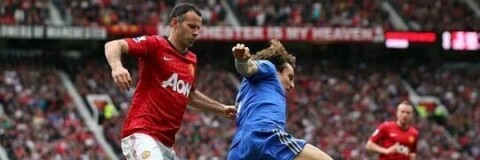Flat
This was the fifth time that United had faced Chelsea this season and with the exception of the league game at Stamford Bridge they have proved difficult opposition. Even then that game had been a tough contest. As Chelsea had still to secure their Champions League place the Champions could expect another tough game.
Personnel
In: Lindegaard, Vidic, Anderson, Cleverley and Giggs.
Out: De Gea, Ferdinand Carrick, Nani and Rooney
Key points
- This was a very flat United performance, illustrating how much they have come to rely on Carrick for creativity.
- The teams cancelled each other out in the centre of the park for much of the match and United restricted the influence of Mata well. The chances that came generally came from breakaways in wide areas, both teams playing fairly narrow.
- The substitutions changed the game, but it was United who effectively committed suicide by going to two in central midfield, one of whom was the fading Giggs. Benitez responded, seized the initiative and his Chelsea side went on to win.
First Half
United started this game in a 4-5-1 shape in defense and a 4-3-3 when in attack. Evans partnered Vidic at the centre of defence which allowed Jones to operate for the second week running in midfield. He played as a pivot behind Anderson to the right and Cleverley to the left. Valencia played wide on the right, and Giggs on the left, both playing as wide midfield players rather than as wingers. Van Persie played as the sole front man and Lindegaard made a rare appearance in goal. Chelsea started in a 4-2-3-1 shape with Ba leading the line ahead of Mata. Oscar and Moses occupied the wide attacking positions. Lampard played ahead of Ramires in the half back positions.
Sir Alex picked a number of players here with little recent match time and this perhaps showed in the performance. The tempo of the game was fairly slow and the play disjointed at times. Mata for Chelsea has had a number of excellent games this year against United and he had clearly been picked out as the danger man. Jones tracked Mata whenever he dropped deep or moved wide, but left him to one or other of the centre backs to pick up when he pushed closer to Ba. From the start both teams attacked on a fairly narrow front. As a consequence they both defended narrowly. This meant that there was plenty of space for the full backs to attack. In the early stages Chelsea was the team making the most of this with Cole and Azpuilicueta finding space to cross. Their delivery was fairly poor. Before long United adjusted and as the half wore on it was United who began to exploit the wide space with Evra and especially Rafael surging forward.
The first half was a fairly even contest with both sides having a number of half chances. The tempo remained fairly low throughout, and the centre of the pitch remained fairly crowded. Both teams found themselves able to retain possession, work the ball around but neither had a great deal of success creating clear cut chances. The chances usually came after a turnover of possession leading to a breakway. Chelsea should have scored from one such situation on 14 minutes when Oscar broke free running from his own half. Lindegaard made a sharp save at his near post. United also had a number of breakaway chances, the best of which came from situations where they were able to switch play quickly from one side of the pitch to the other as they made a rapid break up field. Unfortunately there weren’t that many situations like this.
The stalemate was as a consequence of United’s shape and Chelsea’s over caution. Jones tracked Mata and Cleverley and Anderson positioned themselves in areas where they could restrict the influence of Lampard and Ramires. Chelsea’s wide players needed to do more. United, not needing to force the issue, were flat.
When United attacked van Persie seemed isolated. On one occasion with an opportunity to run at a retreating defender he checked, conscious of his isolation and appeared to wait for support when the obvious option was to press forward and shoot. As the half wore on and perhaps as a result of this issue Giggs began to play slightly higher and significantly narrower on the United left. This gave van Persie some support.
Second Half
Not a lot changed after the half time break. United’s start to the second half was a little sluggish and Chelsea as a consequence played a slightly higher line. This was in part as a consequence of a large number of poor clearances by United. Winning the ball in their own third they failed to find a Red shirt with a pass or clearance out and so the ball kept coming back. This invited Chelsea to push on.
It had been noticeable in the first half that van Persie seemed isolated and this continued in the second half, and it was perhaps this feature that inspired Sir Alex’s first substitutions on 68 minutes. Sir Alex removed Anderson and Cleverley, (both of whom had had unremarkable games) and introduced Rooney and Buttner. United changed shape to a 4-4-2. Rooney partnered van Persie up front, and Giggs moved to central midfield to partner Jones in a pair. Buttner played as a wide attacker on the United left. Buttner wasn’t convincing in this higher position and kept turning away from the Chelsea fullback, returning the ball to the midfield or to Evra behind him. United’s play did improve for a short while, the tempo of their play increased and the presence of Rooney alongside van Persie made Chelsea play a little deeper and saw their defence look less comfortable.
Seeing this change of shape Benitez subsequently made his own substitution and seized the initiative. On 76 minutes Torres replaced Moses and Chelsea switched to a shape closer to a 4-3-3. This instantly meant that Giggs and Jones were outnumbered in the central midfield area and United struggled from this point onwards. Giggs cannot really operate these days as part of a midfield two, and he certainly can’t operate their in the last twenty minutes of a game having played the first seventy. He notably tired here and it was his mistake, giving the ball away cheaply which lead to a move resulting in a Chelsea goal on 87 minutes. United were out of position and Chelsea moved the ball around creating a shooting chance for Mata whose deflected shot beat Lindegaard.
This was tough on Lindegaard who had had a good game and commanded his area well throughout. It was also tough on Evans, Vidic and Jones who had also played well and between them had restricted the influence of Mata up to that point. It was however probably a fair outcome overall as United had played this game without any great sense of purpose, and Chelsea had probably had the better of the chances created.
Rafael was sent off immediately after the goal after reacting to an elbow by Luiz. They should perhaps both have been dismissed. Hernandez replaced Valencia in time added on.
Conclusion
This was a disappointing game for United. They lacked edge, as Sir Alex admitted in his post match interviews. Until he made his substitutions in the middle of the second half however United had held their own fairly comfortably.
Then he changed to a 4-4-2 shape with Giggs as one of a central midfield pair. This doesn’t work; in fact we could list the games when Giggs has been used in this shape unsuccessfully. We won’t out of respect for the player, but safe to say that in our opinion it isn’t really fair to play him in this role anymore.





















